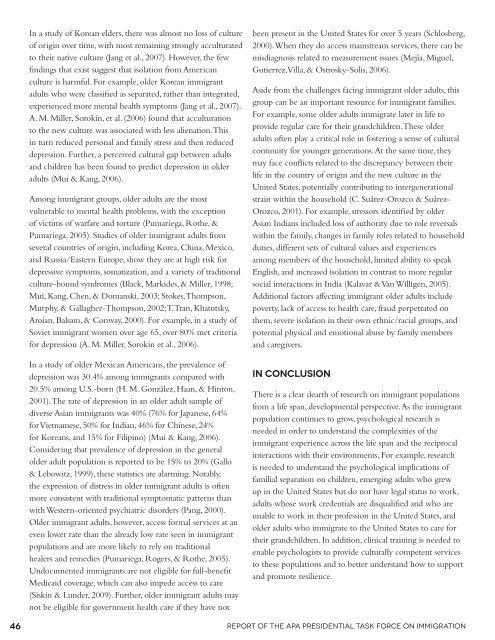Crossroads: The Psychology of Immigration in the New Century
Crossroads: The Psychology of Immigration in the New Century
Crossroads: The Psychology of Immigration in the New Century
Create successful ePaper yourself
Turn your PDF publications into a flip-book with our unique Google optimized e-Paper software.
In a study <strong>of</strong> Korean elders, <strong>the</strong>re was almost no loss <strong>of</strong> culture<br />
<strong>of</strong> orig<strong>in</strong> over time, with most rema<strong>in</strong><strong>in</strong>g strongly acculturated<br />
to <strong>the</strong>ir native culture (Jang et al., 2007). However, <strong>the</strong> few<br />
f<strong>in</strong>d<strong>in</strong>gs that exist suggest that isolation from American<br />
culture is harmful. For example, older Korean immigrant<br />
adults who were classified as separated, ra<strong>the</strong>r than <strong>in</strong>tegrated,<br />
experienced more mental health symptoms (Jang et al., 2007).<br />
A. M. Miller, Sorok<strong>in</strong>, et al. (2006) found that acculturation<br />
to <strong>the</strong> new culture was associated with less alienation. This<br />
<strong>in</strong> turn reduced personal and family stress and <strong>the</strong>n reduced<br />
depression. Fur<strong>the</strong>r, a perceived cultural gap between adults<br />
and children has been found to predict depression <strong>in</strong> older<br />
adults (Mui & Kang, 2006).<br />
Among immigrant groups, older adults are <strong>the</strong> most<br />
vulnerable to mental health problems, with <strong>the</strong> exception<br />
<strong>of</strong> victims <strong>of</strong> warfare and torture (Pumariega, Ro<strong>the</strong>, &<br />
Pumariega, 2005). Studies <strong>of</strong> older immigrant adults from<br />
several countries <strong>of</strong> orig<strong>in</strong>, <strong>in</strong>clud<strong>in</strong>g Korea, Ch<strong>in</strong>a, Mexico,<br />
and Russia/Eastern Europe, show <strong>the</strong>y are at high risk for<br />
depressive symptoms, somatization, and a variety <strong>of</strong> traditional<br />
culture-bound syndromes (Black, Markides, & Miller, 1998;<br />
Mui, Kang, Chen, & Domanski, 2003; Stokes, Thompson,<br />
Murphy, & Gallagher-Thompson, 2002; T. Tran, Khatutsky,<br />
Aroian, Balsam, & Conway, 2000). For example, <strong>in</strong> a study <strong>of</strong><br />
Soviet immigrant women over age 65, over 80% met criteria<br />
for depression (A. M. Miller, Sorok<strong>in</strong> et al., 2006).<br />
In a study <strong>of</strong> older Mexican Americans, <strong>the</strong> prevalence <strong>of</strong><br />
depression was 30.4% among immigrants compared with<br />
20.5% among U.S.-born (H. M. González, Haan, & H<strong>in</strong>ton,<br />
2001). <strong>The</strong> rate <strong>of</strong> depression <strong>in</strong> an older adult sample <strong>of</strong><br />
diverse Asian immigrants was 40% (76% for Japanese, 64%<br />
for Vietnamese, 50% for Indian, 46% for Ch<strong>in</strong>ese, 24%<br />
for Koreans, and 15% for Filip<strong>in</strong>o) (Mui & Kang, 2006).<br />
Consider<strong>in</strong>g that prevalence <strong>of</strong> depression <strong>in</strong> <strong>the</strong> general<br />
older adult population is reported to be 15% to 20% (Gallo<br />
& Lebowitz, 1999), <strong>the</strong>se statistics are alarm<strong>in</strong>g. Notably,<br />
<strong>the</strong> expression <strong>of</strong> distress <strong>in</strong> older immigrant adults is <strong>of</strong>ten<br />
more consistent with traditional symptomatic patterns than<br />
with Western-oriented psychiatric disorders (Pang, 2000).<br />
Older immigrant adults, however, access formal services at an<br />
even lower rate than <strong>the</strong> already low rate seen <strong>in</strong> immigrant<br />
populations and are more likely to rely on traditional<br />
healers and remedies (Pumariega, Rogers, & Ro<strong>the</strong>, 2005).<br />
Undocumented immigrants are not eligible for full-benefit<br />
Medicaid coverage, which can also impede access to care<br />
(Sisk<strong>in</strong> & Lunder, 2009). Fur<strong>the</strong>r, older immigrant adults may<br />
not be eligible for government health care if <strong>the</strong>y have not<br />
been present <strong>in</strong> <strong>the</strong> United States for over 5 years (Schlosberg,<br />
2000). When <strong>the</strong>y do access ma<strong>in</strong>stream services, <strong>the</strong>re can be<br />
misdiagnosis related to measurement issues (Mejía, Miguel,<br />
Gutierrez, Villa, & Ostrosky-Solis, 2006).<br />
Aside from <strong>the</strong> challenges fac<strong>in</strong>g immigrant older adults, this<br />
group can be an important resource for immigrant families.<br />
For example, some older adults immigrate later <strong>in</strong> life to<br />
provide regular care for <strong>the</strong>ir grandchildren. <strong>The</strong>se older<br />
adults <strong>of</strong>ten play a critical role <strong>in</strong> foster<strong>in</strong>g a sense <strong>of</strong> cultural<br />
cont<strong>in</strong>uity for younger generations. At <strong>the</strong> same time, <strong>the</strong>y<br />
may face conflicts related to <strong>the</strong> discrepancy between <strong>the</strong>ir<br />
life <strong>in</strong> <strong>the</strong> country <strong>of</strong> orig<strong>in</strong> and <strong>the</strong> new culture <strong>in</strong> <strong>the</strong><br />
United States, potentially contribut<strong>in</strong>g to <strong>in</strong>tergenerational<br />
stra<strong>in</strong> with<strong>in</strong> <strong>the</strong> household (C. Suárez-Orozco & Suárez-<br />
Orozco, 2001). For example, stressors identified by older<br />
Asian Indians <strong>in</strong>cluded loss <strong>of</strong> authority due to role reversals<br />
with<strong>in</strong> <strong>the</strong> family, changes <strong>in</strong> family roles related to household<br />
duties, different sets <strong>of</strong> cultural values and experiences<br />
among members <strong>of</strong> <strong>the</strong> household, limited ability to speak<br />
English, and <strong>in</strong>creased isolation <strong>in</strong> contrast to more regular<br />
social <strong>in</strong>teractions <strong>in</strong> India (Kalavar & Van Willigen, 2005).<br />
Additional factors affect<strong>in</strong>g immigrant older adults <strong>in</strong>clude<br />
poverty, lack <strong>of</strong> access to health care, fraud perpetrated on<br />
<strong>the</strong>m, severe isolation <strong>in</strong> <strong>the</strong>ir own ethnic/racial groups, and<br />
potential physical and emotional abuse by family members<br />
and caregivers.<br />
In Conclusion<br />
<strong>The</strong>re is a clear dearth <strong>of</strong> research on immigrant populations<br />
from a life span, developmental perspective. As <strong>the</strong> immigrant<br />
population cont<strong>in</strong>ues to grow, psychological research is<br />
needed <strong>in</strong> order to understand <strong>the</strong> complexities <strong>of</strong> <strong>the</strong><br />
immigrant experience across <strong>the</strong> life span and <strong>the</strong> reciprocal<br />
<strong>in</strong>teractions with <strong>the</strong>ir environments. For example, research<br />
is needed to understand <strong>the</strong> psychological implications <strong>of</strong><br />
familial separation on children, emerg<strong>in</strong>g adults who grew<br />
up <strong>in</strong> <strong>the</strong> United States but do not have legal status to work,<br />
adults whose work credentials are disqualified and who are<br />
unable to work <strong>in</strong> <strong>the</strong>ir pr<strong>of</strong>ession <strong>in</strong> <strong>the</strong> United States, and<br />
older adults who immigrate to <strong>the</strong> United States to care for<br />
<strong>the</strong>ir grandchildren. In addition, cl<strong>in</strong>ical tra<strong>in</strong><strong>in</strong>g is needed to<br />
enable psychologists to provide culturally competent services<br />
to <strong>the</strong>se populations and to better understand how to support<br />
and promote resilience.<br />
46 Report <strong>of</strong> <strong>the</strong> APA Presidential Task Force on <strong>Immigration</strong>
















